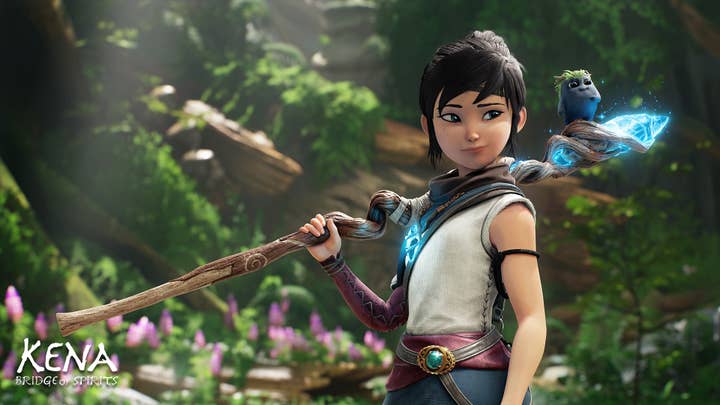From commercial animation to indie game debut success: The story of Ember Lab
Co-founders Josh and Michael Grier discuss applying their background in film, VFX, and producing brand mascots to the studio's debut game Kena: Bridge of Spirits
Ember Lab has been around since 2009, starting out as a company specialising in commercial animation and digital content. But a decade later it would make its mark in video games with the release of Kena: Bridge of Spirits.
So how did its co-founders, COO Josh Grier and chief creative Michael Grier, go from wanting to become filmmakers to making a game that would catch the attention of Sony just as it was preparing to unveil PlayStation 5?
Speaking to the two softly spoken brothers at Develop, the difference between media matters less than being able to tell a story with original content. "We always knew that we wanted to make our own content, we've always been storytellers at heart," says Michael.
"We always knew that we wanted to make our own content, we've always been storytellers at heart"Michael Grier
In fact, "fun learning" came through their commercial work, which also included small mobile games for some clients' advertising campaigns. It was these short development cycles that initially planted the seed that they might be able to make their own game.
"We spent a long time in the commercial world and we learned a lot from the 60-second stories that we had to tell," Josh explains.
These projects also helped shape what Michael refers to as Ember Lab's style, a blend of stylised CG characters in realistically lit and rendered environments.
In the end, deciding to get into games was easier than the uphill struggle to break into film as an independent studio. The real turning point came in 2015 when Epic made Unreal Engine 4 free for all users.
"It was a very artist-friendly platform at the time, and so a lot of our VFX background translated very well to using it," Josh says.

The studio also caught attention with its 2016 CG short film, 'Majora's Mask - Terrible Fate', a tribute to The Legend of Zelda: Majora's Mask, which has amassed more than 13 million views on YouTube to date. It's a lovingly produced fan film for sure, but one the brothers admit was strategic on their part to first get themselves into the gaming sphere's public consciousness.
Nonetheless, rather than leaning on an established franchise or licence, the plan was always to create their own original IP. It was something the studio had plenty of experience already through its commercial work, carving out a niche in making CG characters for companies that would be mascots or brand ambassadors, which one can easily translate to creating a mascot character in a game.
"Organising what we wanted to make into a packagable, pitchable process was something that we learned a lot from the film and animation side"Josh Grier
"Also organising what we wanted to make into a packagable, pitchable process was something that we learned a lot from the film and animation side where we're pitching to brands and different developers," Josh explains. "So it was a great experience on that side, but we had to do a lot when funding for Kena. It was nice to have that in our wheelhouse of knowing how to express what we wanted to make."
Their pitch certainly caught Sony's attention, which not only became a funding partner for Kena: Bridge of Spirits but also provided invaluable marketing support. In fact, the game was officially announced in PlayStation's Future of Gaming stream in 2020 as one of many titles coming to the newly unveiled PlayStation 5.
"It was really cool to debut the game to that many people that fast," says Michael. "But it was also like a huge amount of pressure that was just suddenly turned on. We're a very small team, it's an indie game, and we went from no one knowing about it to a bunch of people wanting it after the show. So then it was like, 'Oh man, now we have to deliver!'"
Being in a showcase dubbed 'future of gaming' also may have led to higher expectations; the critical reception to Kena being often likened to a PS2 platformer. That said, it was something the studio viewed as a compliment rather than criticism, and which was also intentional on its part to make something simple and charming without necessarily reinventing the wheel.
"We pitched an experience that was full of charm and had that nostalgia edge to it," Michael explains. "[PS2-era games] is definitely a big influence, we weren't seeing a bunch of those games being made, so it was like, it'd be fun to play a game like that, a kind of callback to that vibe, and the simplicity of it is part of the charm. So, for better or for worse, that's what we set out to make."
But even without experience in shipping a retail game, the brothers understood that leaning on their animation expertise was not going to make a game. It was therefore important to build a team so that they could defer to the experts.

"We built the game on Blueprint [in Unreal Engine] and then we brought engineers in and we got really fortunate with them as partners in development," explains Josh. "There were lots of learnings that we were strategic about. Our team animation is very skilled, but we hadn't made any games. So we went out and tried to bring team members who had a lot more game experience than we had to kind of give us pointers and it was a great merging of the minds in terms of balancing what we knew we wanted in look and feel, but also making that desire realistic to ship."
He adds that the final version of Kena was actually considerably bigger in scope than the way it was originally envisioned. While they hadn't set out to make a title that would be a game-changer, they were nonetheless pleased with having a unique mechanic through the Rot, the game's mascot characters.
"In the original prototypes, they were like enemies that would mob you and the whole game was just you running away from them. Then at some point in development, we switched it to, what if we could use them to fight enemies?"Michael Grier
"In the original prototypes, they were like enemies that would mob you and the whole game was just you running away from them," explains Michael. "Then at some point in development, we switched it to, what if we could use them to fight enemies? Once we made that switch, everything sort of fell into place with the story and how we're going to use the characters in the world – it all sort of clicked."
But when it comes to adapting from being an ad agency to a game development studio, the most challenging learning was communication.
"We had 15 people on Kena, but when we were doing our agency work, we were like four or five people," says Josh. "Communication was really easy, we had a shorthand, and we were also working on much simpler projects. Now you've got a team with a lot of external developers across the world and your shorthand in the studio is not just gonna be us saying something in a meeting and everybody gets it.
"That's just the nature of game development, where we have to untangle to communicate any idea across all departments, because you need the whole team to work towards that goal," Michael adds. "In the early part of game development, it's very nebulous and everyone has a little bit of a different idea about what the game is gonna end up being. because you can't play it. So just finding a way to communicate and unify a clear vision to the team over the course of three, four years, as it's evolving, that's probably one of the most challenging things for me. Game development is tough!"
Having achieved success with Kena, with the game breaking even within a month of release while also winning Best Debut at The Game Awards, the team has felt energised and driven to do even better with their next project – although what that might be is something the brothers aren't able to share during our interview. But while it may be natural in game development for the next project to iterate and expand on the previous title, they also want it to stay manageable in scope.
"I guess you can call us aging gamers, people who have less time to play things, so things that are more approachable from a scope perspective are always more appealing to us," says Josh. "We'll try to do something a little bit more ambitious as we grow, but we're still trying to be conscious of making something that's digestible and something that we will want to play as gamers right now in our current pace of life with kids and stuff."
Indeed, their next project need not even necessarily be a game – but don't expect a Kena movie either. In any case, the game's success has opened up the possibilities of what Ember Lab does next.
"We're filmmakers by trade, and essentially, we'd like to look at linear media," Josh explains. "There's great examples out there in the world. Something like Kena exploring the universe in different mediums outside of the interactive ones. There's a lot of opportunities out there. We'd love to do that."

